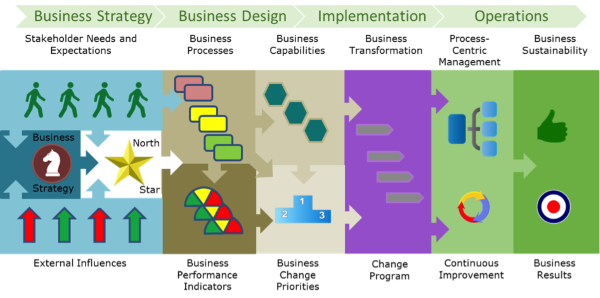No Business like Business Architecture
07th of February 2016There’s nothing like the feeling of growth you get when you revisit a brilliant idea from your past, and improving it through experiences you had over the last few years. That is one of the reasons Roger Burlton’s revisiting of his Hexagon and its subsequent reshaping into a new model holds such fascination with me. The fact of that even with the greats of Business Process Management, experience is merged with insight to form something to benefit the collegial assembly of architects.
For those of you not familiar with the Burlton Hexagon, here’s a quick recap. The hexagon was created by Roger Burlton around 1995 as a model to incorporate all attributes of a capability or business process in various aspects. These processes and capabilities were to be at any level of detail, from the value chains down to the individual process decomposition. The model is to be a bull’s eye view of business performance by aligning all relevant components and using processes as the measurable organizing or synchronizing asset. The hexagon is shown in the illustration below.

Looking at the subdivisions of the bull’s eye, Business Performance is identified by the measure of value of processes in different categories (efficiency, effectiveness, adaptability…), and these processes are described with the identification of all units of work from the opening trigger to the closing event, as well as the interdependencies between these units of work (or activities). Information is the listing of all inputs, outputs and references in a business process, and how this data relates to the process in focus. Knowledge is the information that guides the execution of such a process, or is created by processes to be used in others. This could be construed as information turned strategically relevant by use of processes in order to be in line with the definition of information and knowledge as stipulated by Robert Logan.
Intent and Strategy define the Raison d’Etre for the business and form the basis for traceability and prioritization within the processes. This is where the vision, goals and objectives are tied in with the perspectives of the enterprise and the stakeholders. For me personally, this would be filled in with a Business Motivation Model. The Policies and Rules blocks speaks for itself, namely a repository for all legislation, business policies, governance requirements, compliance needs... The Organization Structure completes the upper blocks of the hexagon, with a description of the structural aspects of the enterprise.
Where the top of the hexagon focuses on the contexts and goals of the process, the bottom consists of the enablers of the process. These assets can be leveraged in order to execute the process to its proper conclusion. The assets are divided into Human Capital (listing the skills, abilities, knowledge, education needs, individual motivation…), Enabling Technologies and supporting infrastructure (work locations, distribution capabilities, equipment, health and safety provisions, fleet…).
The concepts in this hexagon have shifted position in Burlton’s new approach to Business Architecture, as seen in the next illustration. Swapping the position of Business Performance Indicators with that of Business Capabilities shows a tighter correlation between processes and capabilities. The scope of such an exercise should always be in the back of our minds, and Burlton tackles this by linking it to the value chain(s) of the enterprise. An argument for this is the fact that when taking a departmental segmentation, business capabilities tend to be defined within the boundaries of such departments, limiting the capabilities to the functional ones, and omitting the cross-functional capabilities.

Roger Burlton is doing a column per section of this business architecture model over at BPTrends. I highly recommend following up on these articles, as it grants insights, if not always in line with one’s proper view on a business architecture approach. As with every approach, absorb with you can use, and discard the rest.
| Thought | Business Architecture | BPM |